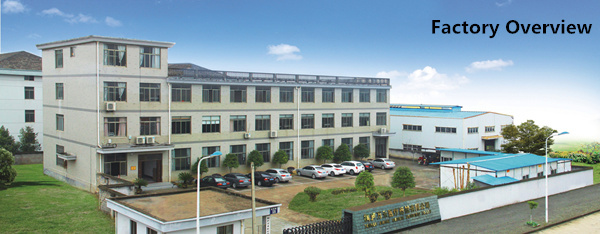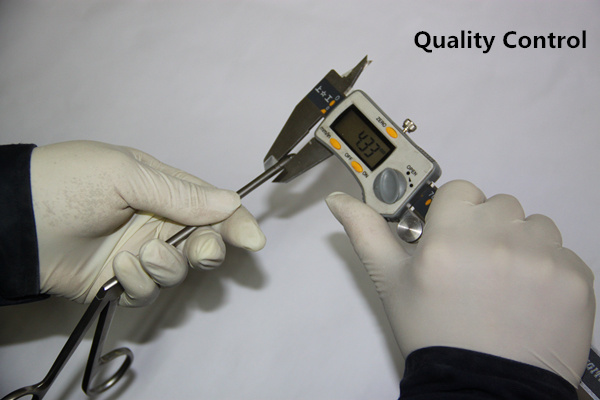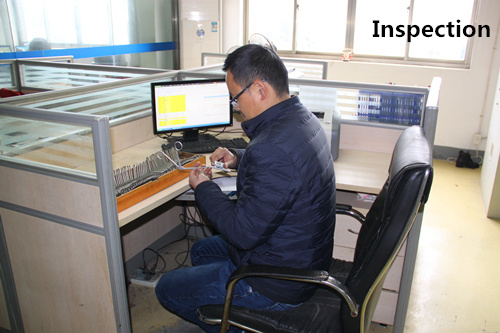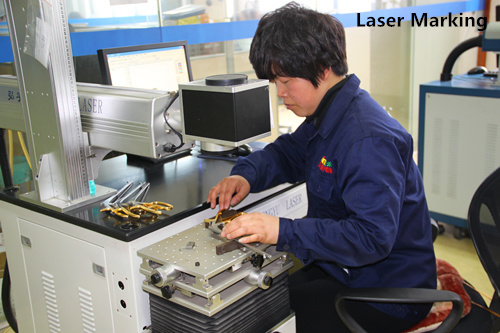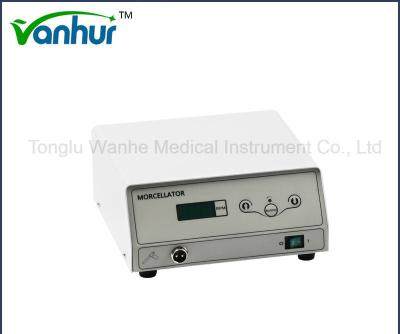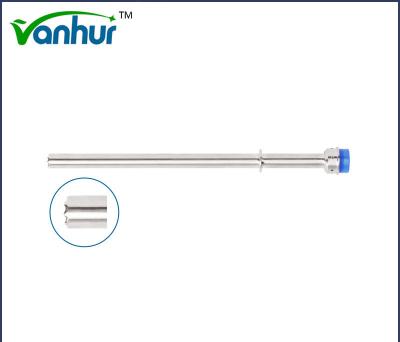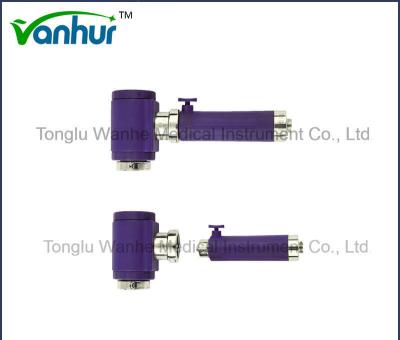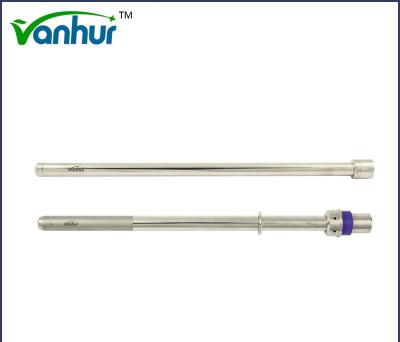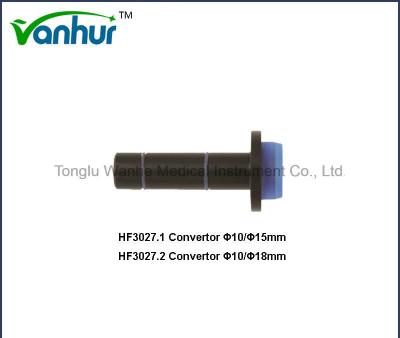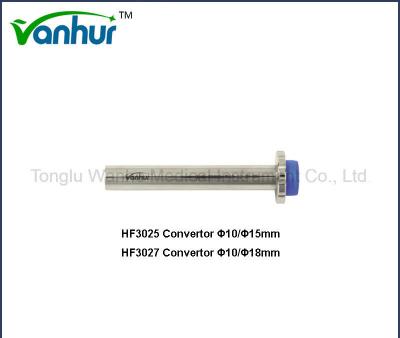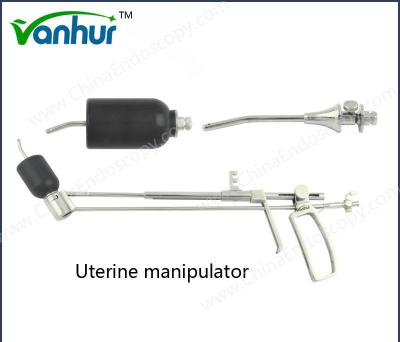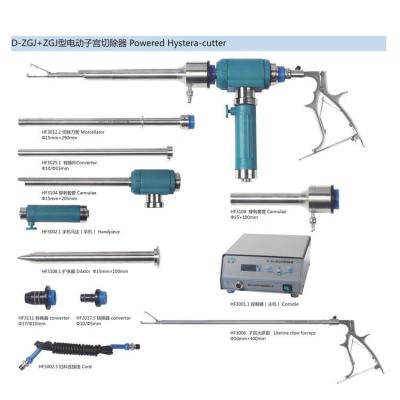1 Introduction: The compact control unit Morcellator with its simple and intuitive operation panel controls the speed of the attached instruments. For the morcellation of tissue speeds of up to 700 RPM are appropriate. The Morcellator attached instruments include Cutting tubes, Obturator, Trocar sleeve, Dilator, Guiding bar, Convertor, Uterine forceps. To suit the needs of every procedure the model range of the Morcellator consist of instruments with three different diameters. They are available in diameter 10, 15 and 18 mm. By carefully composed and aligned instruments and accessories the system as a whole delivers excellent results at morcellation and guarantees for maximum safety at operation.
If you are looking for minimally invasive surgery medical instruments with good quality, competitive price and reliable service. Wanhe medcal is manufaturing these for you. We provide general and professional laparoscopic instruments with CE, FDA approved.
2 Specifications 1 Adopt optimum quality stainless steel material 2 Corrosion resistant
3 Tough construction
4 Light weight and easy operation
5 Fast and safe Morcellator Set For Your Reference: | Model | Name | Specifications |
| HF5002 | Morcellator Console | / |
| HF7005.2 | Handpiece/Gear unit/Handle | / |
| HF3002 | Cutting tube | Φ10x260mm |
| HF3012.2 | Cutting tube | Φ15x260mm |
| HF3012.7 | Cutting tube | Φ18x260mm |
| HF3016 | Guiding bar | Φ10x260mm |
| HF3024 | Dilator | Φ10/Φ15mm |
| HF3028 | Dilator | Φ10/Φ18mm |
| HF3023 | Trocar sleeve | Φ15mm |
| HF3026 | Trocar sleeve | Φ18mm |
| HF3025 | Convertor | Φ10/Φ15mm |
| HF3027 | Convertor | Φ10/Φ18mm |
| HF3025.1 | Convertor | Φ10/Φ15mm |
| HF3025.2 | Convertor | Φ10/Φ18mm |
| HF3027.1 | Convertor | Φ10/Φ15mm |
| HF3027.2 | Convertor | Φ10/Φ18mm |
| HF3006 | Uterine forceps large | Φ10x400mm |
| HF3006.1 | Uterine forceps small | Φ5x400mm |
| HF3016.1 | Obturator | Φ15x260mm |
| HF3016.2 | Obturator | Φ18x260mm |
3 Packing & Shipping:
| Package detail: | Poly bag and special shockproof paper box. |
| Delivery detail: | By air |
4 Company Show






FAQ
What impact does minimally invasive gynecological surgery have on patients’ postoperative recovery?
Post-surgery Enhanced Recovery Guide
Fuzhou Center for Disease Control and Prevention’s New Year’s Eve Party
Minimally invasive gynecological surgery, especially laparoscopic surgery, has a significant impact on patients' postoperative recovery. The following is a detailed breakdown based on the information I searched:
Less trauma and less pain: Compared with traditional open surgery, minimally invasive surgery has less trauma, less bleeding, and less postoperative pain. This allows patients to recover more quickly after surgery and reduce dependence on pain medications.
Rapid recovery: The application of accelerated recovery care model (ERAS) in gynecological laparoscopic surgery can effectively promote patients’ postoperative recovery. This model can significantly reduce the incidence of complications, shorten hospitalization time and recovery time through measures such as early mobilization, immediate feeding and pain management. In addition, early ambulation can help patients improve anal exhaust, reduce pain and shorten hospital stay.
Psychological support: Postoperative patients are prone to negative emotions such as fear and anxiety, which can aggravate stress reactions and affect postoperative recovery.
. Therefore, providing psychological support and comfort is an important part of accelerating recovery. Nursing staff need to communicate effectively with patients to help them adjust their mentality and actively face postoperative recovery.
Complication prevention: Although minimally invasive surgery is less invasive, there is still a certain risk of complications, such as abdominal distension, deep vein thrombosis, urinary retention, anemia caused by intraoperative blood loss, urinary tract injury, etc. The occurrence of these complications can be effectively prevented through reasonable nursing intervention, such as instructing patients to turn over more frequently, perform circular abdominal massage, and ultrasound therapy.
Improved quality of life: Minimally invasive surgery can usually better preserve the patient's physiological functions and quality of life due to its small trauma and quick recovery.
. For example, in pelvic floor reconstruction surgery, vaginal hysterectomy not only has less trauma and less bleeding, but also has less interference with the intestines. The intestinal function recovers early and the bladder function recovers quickly after surgery, reducing unnecessary trauma.
Importance of post-operative care: Effective post-operative care is crucial to ensure surgical results and promote patient recovery. Medical advice must be strictly followed in terms of wound care, dietary intake, activity precautions and life guidance. In addition, traditional Chinese medicine methods such as acupoint massage combined with moxibustion have also been proven to be effective in relieving postoperative discomfort.
In short, minimally invasive gynecological surgery has a positive impact on patients' postoperative recovery, but at the same time, attention should be paid to preventing complications and providing comprehensive psychological support. Through scientific and reasonable nursing measures, patient satisfaction and quality of life can be maximized.
Which specific complications are most common in minimally invasive gynecological surgery, and what are their prevention measures?
In minimally invasive gynecological surgery, common complications include uterine perforation, bleeding, infection, air embolism, bladder or intestinal injury, etc. The following are specific complications and their prevention measures:
Uterine perforation:
Incidence: Literature reports vary, but the incidence of uterine perforation during hysteroscopic surgery is approximately 0.26% to 0.58%.
High-risk factors: including cervical stenosis and difficulty in dilation, excessive incision or damage to the uterine muscle wall, large submucosal fibroids, intrauterine adhesions, and uterine malformations.
Preventive measures: Assess the patient's basic disease and uterine condition before surgery, and strictly control the indications for surgery; closely monitor vital signs during surgery, standardize operations, and avoid excessive force.
Bleeding:
Incidence: The incidence of bleeding during hysteroscopic surgery is 0.03%.
Preventive measures: Make adequate preparations before surgery, including assessing the patient's coagulation function; pay attention to controlling bleeding during surgery and stopping bleeding in a timely manner.
Infect:
Type: Postoperative infection is common in incision surface cellulitis, deep incision abscess, pelvic or vaginal stump cellulitis or abscess.
Preventive measures: Use antibiotics as appropriate to prevent infection, especially for patients with high risk factors for infection; strengthen postoperative care and keep the wound clean and dry.
Air embolism:
Incidence: The incidence of air embolism during hysteroscopic surgery is 0.03%.
Preventive measures: Strictly control the amount of uterine distension solution used to avoid excessive absorption syndrome; closely monitor blood gas analysis during the operation to prevent gas from entering the blood circulation.
Bladder or bowel injury:
Incidence: The incidence of bladder or bowel injury during hysteroscopic surgery is 0.02%.
Preventive measures: Carefully separate tissues during surgery to avoid accidental damage to adjacent organs; detect and repair damaged areas promptly after surgery.
Other complications:
Pain, nausea and vomiting: common postoperative complications that require prompt treatment and close monitoring.
Deep vein thrombosis, urinary retention: These complications also require comprehensive nursing intervention to prevent and manage.
What specific impact does early mobilization after minimally invasive gynecological surgery have on patient recovery?
Early mobilization after minimally invasive gynecological surgery has a significant positive impact on patient recovery. According to multiple studies and clinical practice guidelines, early mobilization improves patients’ recovery speed, reduces complications, and improves overall satisfaction.
Early ambulation can help promote the recovery of intestinal and lung function. Research shows that early mobilization can shorten the time it takes to pass anal gas, reduce pain, and significantly reduce the number of days in the hospital. For example, in gynecological laparoscopic surgery, the intervention group (i.e., patients who underwent early ambulation) had significantly less anal exhaust time and incidence of neck and shoulder pain than the control group, and had shorter hospitalization days and higher patient satisfaction.
Additionally, early mobilization can prevent deep vein thrombosis and other postoperative complications. With early mobilization, patients can regain muscle strength and circulatory function more quickly, thereby reducing the risk of thrombosis. In some studies, early postoperative mobilization has been shown to reduce hospital stay and improve motor function, gait, balance, and muscle strength.
In addition, early activity also has a positive effect on the psychological state. Early postoperative mobilization not only helps with physical recovery, but also enhances the patient's psychological confidence and reduces anxiety and depression.
In conclusion, early mobilization after minimally invasive gynecological surgery has many benefits for patient recovery, including shortening hospital stay, reducing pain, promoting recovery of bowel and lung function, preventing complications, and improving patient satisfaction.
How to effectively provide psychological support to accelerate the recovery process after minimally invasive gynecological surgery?
Effectively providing psychological support to accelerate the recovery process after minimally invasive gynecological surgery requires comprehensive intervention from multiple aspects. Here are detailed recommendations:
Preoperative psychological preparation:
Understanding and education: Through face-to-face communication with patients, we share successful cases of surgery to help patients fully understand the surgical process, anesthesia methods, postoperative recovery and other information, answer patients' questions, and reduce their fear of the unknown.
Emotional support: Nurses and doctors should treat patients with understanding, sympathy and respect, and teach them how to cooperate with doctors and nurses to enhance their sense of security during surgery.
Intraoperative care:
Communication skills: During the operation, medical staff should take the initiative to talk to the patient, pay attention to their physiological feelings, adjust the indoor environment according to needs, maintain silence, and avoid irritating language or conversations to increase the patient's sense of security and trust.
Psychological comfort: Use eye encouragement, verbal hints and other means to improve the patient's psychological sense of security and make them better cooperate with the surgery.
Postoperative psychological care:
Early detection of psychological problems: timely detection of patients’ psychological problems after surgery and active counseling and psychological counseling to help them adjust their mentality and actively face recovery.
Social support: Encourage family members and relatives to visit to relieve the patient's loneliness. At the same time, we actively help the patient seek support from family members, so that the patient can feel the warmth of family affection, relieve negative emotions, and improve confidence in recovery.
Behavioral training: Intervention through behavioral training and other methods, such as guiding patients to perform abdominal breathing, listening to soothing music, etc., to relieve negative emotions.
Systematic psychological intervention:
Individualized psychological support: Based on the patient's individual characteristics such as education level, personality, and receptive ability, different languages and communication skills are used to provide targeted psychological counseling and vent their negative emotions.
Emotional management: Teach patients how to regulate psychological stress and establish the concept of accepting surgical treatment with positive emotions.
Nutritional and physiological care:
Dietary guidance: Develop a reasonable diet plan for the patient, eat more vitamin-rich foods, improve gastric function, pay attention to a light diet, and avoid highly processed foods.
Pain management: Based on the pain assessment results, appropriate analgesic measures are given to reduce the patient's postoperative pain.
Prevent complications:
Complication prevention care: Pay attention to observe whether patients have postoperative complications, such as infection, bleeding, urinary retention, etc., and take timely preventive and treatment measures to ensure patient safety.
What are some case studies of improved quality of life after minimally invasive gynecological surgery?
Case studies on improving quality of life after minimally invasive gynecological surgery focus on laparoscopic myomectomy and total laparoscopic hysterectomy. Here are a few specific case studies:
The study conducted a retrospective analysis of 112 patients based on the European Five-Dimensional Health Scale (EQ-5D-5L). The results showed that the quality of life gradually improved on the 3rd, 7th and 14th days after surgery, and was consistent with the surgery. There was no association with time, intraoperative blood loss, number of fibroids, or maximum fibroid diameter.
. However, postoperative quality of life was significantly negatively correlated with the number and volume of fibroids, indicating that the greater the number of fibroids, the slower the postoperative recovery.
Research shows that the concept of rapid recovery nursing can effectively reduce the negative effects of surgery and improve patients' quality of life. Through high-quality nursing intervention programs, patients' physical and psychological stress can be reduced, thereby improving their overall quality of life.
Research from Longhua Hospital Affiliated to Shanghai University of Traditional Chinese Medicine shows that high-quality nursing intervention can significantly improve patients' sleep quality and quality of life. Through methods such as relaxation function training and cognitive behavioral therapy, we help patients release psychological stress, overcome negative emotions, and thereby improve their quality of life.
This study conducted specific individualized nursing intervention on 60 patients and found that the quality of life of the patients in the observation group was significantly higher than that of the control group after the intervention. By establishing a good nurse-patient relationship, explaining disease knowledge, relaxation function training and cognitive behavioral therapy, the quality of life of patients has been effectively improved.
These studies show that patients' quality of life can be significantly improved after minimally invasive gynecological surgery through reasonable surgical methods and effective nursing interventions.
What are the results of the study comparing post-operative recovery time between minimally invasive gynecological surgery and traditional open surgery?
According to multiple lines of evidence, there is a significant difference in postoperative recovery time between minimally invasive gynecological surgery and traditional open surgery. Specifically:
Postoperative recovery time:
Traditional open surgery: Postoperative recovery is slower, usually requiring 7 to 15 days of hospital stay.
Minimally invasive surgery: Recovery is faster after surgery and you can be discharged from the hospital in just 3 to 5 days.
Length of stay:
Traditional open surgery: Hospital stay is 7 to 15 days.
Minimally invasive surgery: Hospital stay shortened to 3 to 5 days.
Pain and complications:
Traditional open surgery: There is often pain at the incision site after surgery, and infection and complications may occur.
Minimally invasive surgery: Patients complete the surgery under intravenous anesthesia, with less postoperative pain and almost no bleeding, reducing damage to organs and functional interference.
other factors:
Traditional open surgery: the wound is large (usually greater than 10 cm), affects the appearance, and the amount of bleeding is large.
Minimally invasive surgery: The incision is only 0.5 to 1 cm, leaving basically no scars, clear vision, fine blood vessel treatment, and the use of advanced hemostatic equipment such as ultrasonic scalpel to effectively reduce the amount of bleeding.
Based on the above information, it can be concluded that minimally invasive gynecological surgery is significantly better than traditional open surgery in terms of postoperative recovery time, with shorter hospital stay and lower pain and risk of complications.
For more photos and details please contact me:
Company Name: Tonglu Wanhe Medical Instruments Co., Ltd.
Sales Manager: Sue


